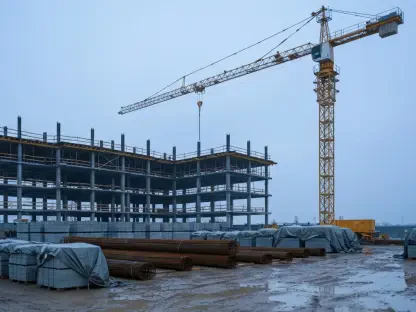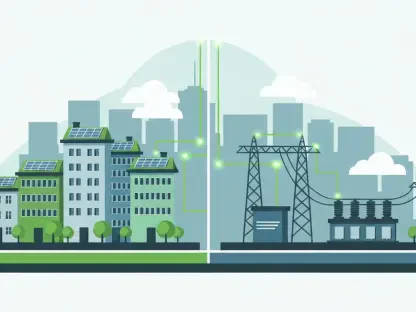Australia’s commercial property sector faces a challenging yet potentially rewarding trajectory as it navigates the current economic landscape and looks ahead to 2026. The sector comprises diverse segments, such as office, retail, and industrial properties, each reacting uniquely to prevailing economic conditions. Recent developments have shown a mixed bag of outcomes that paint a picture of both growth opportunities and persistent hurdles. In the first quarter of the current year, Australia’s economic growth underwhelmed, with a real GDP growth rate reduced to 1.3 percent, down from 0.6 percent late last year, indicating some economic volatility. The decline in retail sales added to these concerns, manifesting despite lowered borrowing costs and easing inflation. Adding to the complex economic backdrop are natural disasters, which have culminated in financial impacts reaching $2.2 billion. Furthermore, the uncertainties surrounding U.S. tariff policies create additional ripples within investment, output, and employment spheres in Australia, as highlighted by the Reserve Bank of Australia. Against this economic backdrop, industry experts are carefully optimistic about the sector’s prospects. Although there are evident challenges, there are also promising opportunities for growth as macroeconomic conditions begin to improve.
Economic Challenges and Sector Resilience
The commercial property sector’s resilience appears to be gradually rising, buoyed by improved macroeconomic conditions starting from mid-last year. This is clearly reflected in the overall moderation in interest rate policies globally, which Australia eventually adopted. Although domestic inflationary pressures remained a challenging factor throughout last year, subsequent rate cuts, as witnessed earlier this year, have been noticed by investors keenly watching the sector’s trajectory. Global tensions, particularly those emanating from ongoing U.S. tariff conflicts, continue to sway equity markets, drawing attention and caution from property investors. However, these very uncertainties contribute to expectations of additional rate cuts, potentially ushering in yield compressions, particularly in central markets dominated by core assets.
Investment sentiment has experienced fluctuations in response to these volatile market conditions, yet certain segments have begun to show promise. The industrial property sector, in particular, stands out with signs of robust recovery. It has increasingly become a preferred choice for investors seeking stable returns amidst unpredictable currency markets and volatile global trade scenarios. This shift in investor perception has broadened the audience investing in industrial properties, thus fortifying asset valuation. As a result, industrial capital value growth at the national level is forecasted to achieve a remarkable annual increase of 8.7 percent by the end of the year, marking its most significant improvement since the third quarter three years ago. Nevertheless, market variability exists, with Melbourne contributing significantly to supply, while Sydney’s share diminishes notably, dipping to its lowest since 2015.
Retail Dynamics and Recovery Prospects
The retail sector, another pivotal pillar within Australia’s commercial property domain, is witnessing notable shifts. Central Business Districts, which previously struggled with high vacancy rates, are experiencing signs of renewal. This revitalization is partly driven by an uptick in urban workforce populations, although reports released earlier this year have induced wariness among market participants. Vanessa Hoey, a Director at Herron Todd White, emphasizes the essential role of imminent rate cuts in bolstering investor and consumer trust within retail domains. Despite signs of mixed-use development—integrating retail spaces with medical, childcare, office, and residential applications—leasing conditions remain strenuous. This strain is linked to curtailed retail spending, which is compounded by increasing operational costs, thereby exerting pressure on the affordability aspect for retailers.
Regional variations in the retail landscape further underscore its dynamic nature. Perth stands out with encouraging metrics, showcasing growth within the retail segment. Earlier this year, the median sale price per square meter surged to $5,238, embodying a 23.8 percent year-on-year increase. This reflects heightened investor interest amidst limited opportunities and diminished yields in the industrial market. Meanwhile, metropolitan areas such as Sydney and Melbourne are achieving reductions in retail vacancy rates, aligning with the overarching trend of growing investor interest driven by solid population growth figures. These developments indicate a reinvigorated focus on retail spaces, pushing towards a balanced recovery while investors navigate evolving economic variables.
Analyzing Emerging Trends and Economic Outlook
The intricate landscape of Australia’s commercial property sector is inherently tied to wider macroeconomic indicators and shifting investor sentiments. As the nation continues its economic journey, encapsulating unpredictable elements such as global trade policies, investment outlooks, and economic risk mitigation becomes imperative for sustained growth within the sector. Knight Frank’s Chief Economist Ben Burston reflects on the potential that lies ahead, noting that the most challenging economic news may have passed, setting the stage for guarded optimism. In navigating these waters, the sector is primed to adapt through strategic rate adjustments and confident investor engagement.
While Australia charts its course towards economic stabilization, the commercial property sector’s capacity to absorb oscillating market forces will be scrutinized. The interplay between macroeconomic conditions and sector adaptability will ultimately determine its trajectory, as the nation approaches the next calendar year. With office, retail, and industrial segments presenting distinctive opportunities and challenges, stakeholders are tasked with a multifaceted endeavor towards capitalizing on evolving dynamics and harnessing recovery momentum.
Pathway to Recovery and Future Considerations
The resilience of the commercial property sector appears to be improving, thanks to better macroeconomic conditions since the middle of last year. A notable element of this recovery is the global trend toward more accommodating interest rate policies, which Australia eventually embraced. While domestic inflation was a significant issue last year, recent interest rate cuts in early 2023 have captured the attention of investors who are closely monitoring the sector’s progress. Meanwhile, ongoing global tensions, particularly those related to U.S. tariff conflicts, impact equity markets and warrant caution from property investors. Ironically, these uncertainties also fuel predictions of further rate reductions, which could bring about yield compressions, especially in central markets with core assets.
Investment sentiment has been volatile, yet some segments show promise. The industrial property sector is notably on the rise, providing stable returns amid unpredictable currency markets and global trade volatility. This has convinced more investors to pivot toward industrial properties, strengthening asset valuations. Capital values in this sector are expected to rise significantly—forecasted at an impressive 8.7% annual increase by year’s end, marking notable growth since Q3 three years prior. However, the market isn’t uniform: Melbourne has been a major contributor to supply increases, whereas Sydney’s share has dropped to its lowest since 2015.









